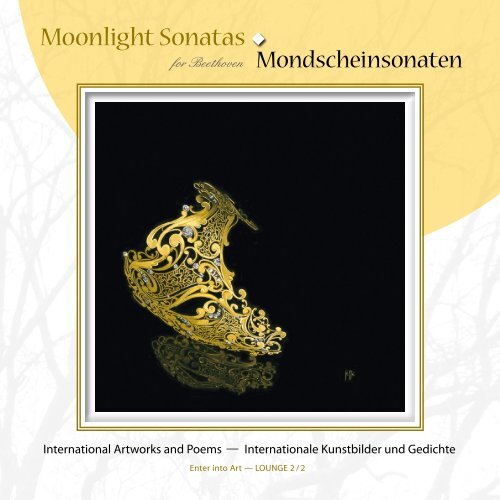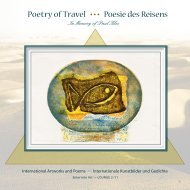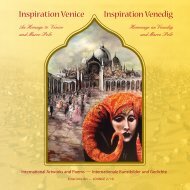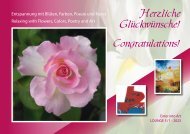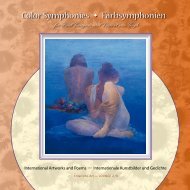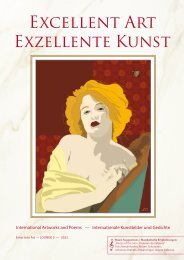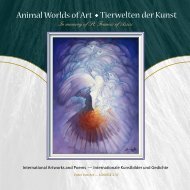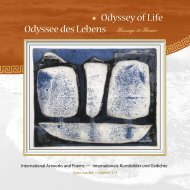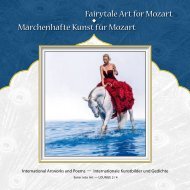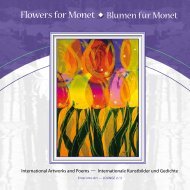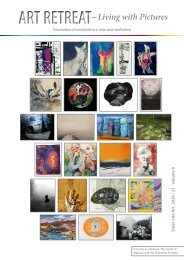Moonlight Sonatas - Mondscheinsonaten - for Beethoven
Name a tune you want to listen to again and again, because it goes straight to the heart. Millions on the internet click “Moonlight Sonata” in response to this call. At the occasion of Beethoven’s 250th birthday and - with boundless sensitivity - 69 artists from 26 countries got together and interpreted the “Moonlight Sonata” in visual terms. Was it not the image of a landscape, after all, that led to the work’s famous epithet? In a way, listening to the sonata resembles looking at a landscape painting by Caspar David Friedrich or William Turner, and losing oneself in the rapt observation of the distant satellite. The editor of this art-inspired almanac has divided the artists’ visual ideas into different chapters, and accentuated them with selected haiku poetry, exquisite quotes, art-inspired slogans and illustrations. The result is a multifaceted homage. The printed book is available in the book trade and in internet bookshops. Softcover: ISBN 978-3-98527-148-1, Publisher: Re Di Roma-Verlag, Language: English, German, Size: 21 x 21 cm Or at Peecho (soft- and hardcover) by the following link: https://www.peecho.com/checkout/161866719083658635/1008226/moonlight-sonatas-for-beethoven-mondscheinsonaten Ein Musikstück, das man immer wieder hören will, weil es unmittelbar ins Herz trifft? Millionen von Klicks im Internet beantworten diese Frage mit „Mondscheinsonate“. Anlässlich des 250. Geburtstages von Ludwig van Beethoven fanden sich 69 Künstler aus 26 Ländern zusammen, um die „Mondscheinsonate“ in bildhafter Weise und mit grenzenloser Einfühlungsgabe zu interpretieren. War es nicht auch das Bild einer Landschaft, welches ihr den berühmten Beinamen gab? Man kann die Sonate hören und wie in einer Landschaftsszenerie von Caspar David Friedrich oder William Turner in der andächtigen Betrachtung des fernen Trabanten versinken. Der Herausgeber dieses kunstbeseelten Almanachs hat die bildlichen Gedanken der Künstler in verschiedene Kapitel aufgeteilt und durch ausgewählte Haiku-Lyrik, erlesene Zitate, sowie kunstästhetische Slogans und Illustrationen untermalt. Dadurch wurde eine vielseitige Hommage geschaffen.
Name a tune you want to listen to again and again, because it goes straight to the heart. Millions on the internet click “Moonlight Sonata” in response to this call. At the occasion of Beethoven’s 250th birthday and - with boundless sensitivity - 69 artists from 26 countries got together and interpreted the “Moonlight Sonata” in visual terms. Was it not the image of a landscape, after all, that led to the work’s famous epithet? In a way, listening to the sonata resembles looking at a landscape painting by Caspar David Friedrich or William Turner, and losing oneself in the rapt observation of the distant satellite. The editor of this art-inspired almanac has divided the artists’ visual ideas into different chapters, and accentuated them with selected haiku poetry, exquisite quotes, art-inspired slogans and illustrations. The result is a multifaceted homage.
The printed book is available in the book trade and in internet bookshops. Softcover: ISBN 978-3-98527-148-1, Publisher: Re Di Roma-Verlag, Language: English, German, Size: 21 x 21 cm
Or at Peecho (soft- and hardcover) by the following link:
https://www.peecho.com/checkout/161866719083658635/1008226/moonlight-sonatas-for-beethoven-mondscheinsonaten
Ein Musikstück, das man immer wieder hören will, weil es unmittelbar ins Herz trifft? Millionen von Klicks im Internet beantworten diese Frage mit „Mondscheinsonate“. Anlässlich des 250. Geburtstages von Ludwig van Beethoven fanden sich 69 Künstler aus 26 Ländern zusammen, um die „Mondscheinsonate“ in bildhafter Weise und mit grenzenloser Einfühlungsgabe zu interpretieren. War es nicht auch das Bild einer Landschaft, welches ihr den berühmten Beinamen gab? Man kann die Sonate hören und wie in einer Landschaftsszenerie von Caspar David Friedrich oder William Turner in der andächtigen Betrachtung des fernen Trabanten versinken. Der Herausgeber dieses kunstbeseelten Almanachs hat die bildlichen Gedanken der Künstler in verschiedene Kapitel aufgeteilt und durch ausgewählte Haiku-Lyrik, erlesene Zitate, sowie kunstästhetische Slogans und Illustrationen untermalt. Dadurch wurde eine vielseitige Hommage geschaffen.
You also want an ePaper? Increase the reach of your titles
YUMPU automatically turns print PDFs into web optimized ePapers that Google loves.
<strong>Moonlight</strong> <strong>Sonatas</strong><br />
<strong>for</strong> <strong>Beethoven</strong> <strong>Mondscheinsonaten</strong><br />
International Artworks and Poems — Internationale Kunstbilder und Gedichte<br />
Enter into Art — LOUNGE 2 / 2<br />
1
Kurt Ries (editor/Hrsg.)<br />
<strong>Moonlight</strong> <strong>Sonatas</strong> <strong>for</strong> <strong>Beethoven</strong><br />
<strong>Mondscheinsonaten</strong> für <strong>Beethoven</strong><br />
Relax and Rejoice with Art and Poetry from Twenty-Six Countries<br />
Entspannung und Genuss mit Kunst und Poesie aus sechsundzwanzig Ländern<br />
73 artworks<br />
28 poems<br />
73 Kunstbilder<br />
28 Gedichte<br />
Cover: Jette van der Lende<br />
Back of the book / Cover-Rückseite: Herbert Hermans, Judith E. Stone<br />
Title page / Titelseite: Ann Dunbar<br />
2<br />
3
Friedrich Schlegel<br />
Friedrich Schlegel<br />
Introduction<br />
The work of Ludwig van <strong>Beethoven</strong> (1770 - 1827) is an international cultural treasure. As an artist and editor of intercultural art books living near Bonn, the occasion<br />
of the composer’s 250th birthday gave me the idea to publish an homage in the <strong>for</strong>m of a gift book. <strong>Beethoven</strong>’s birthplace is located on Bonngasse, and the organ<br />
played by the child prodigy once stood inside the Castle Church opposite the lodge built and reserved <strong>for</strong> the elector from whose liberal spirit Bonn benefitted<br />
greatly. <strong>Beethoven</strong> learned to play piano, organ, and violin at an early age. He became an employee of the court chapel and was soon appointed as the court’s<br />
second organist. <strong>Beethoven</strong>’s mentor was Christian Gottlob Neefe from Leipzig who had been court organist in Bonn since 1782. Neefe was strongly influenced by<br />
Carl Philipp Emanuel Bach, which he passed on to <strong>Beethoven</strong>. The cultivated van Breuning family in Bonn also extended great support to the talented youth. In 1792,<br />
the composer accepted Joseph Haydn’s invitation to go to Vienna, where he also met Mozart. Apart from Haydn, Johann Georg Albrechtsberger and Antonio Salieri<br />
were also <strong>Beethoven</strong>'s teachers. While his stay in Vienna had begun as an educational trip, due to political circumstances, he remained there <strong>for</strong> the rest of his life.<br />
Among the Viennese nobility, he was especially admired <strong>for</strong> his skill at free improvisation. <strong>Beethoven</strong> wrote his “<strong>Moonlight</strong> Sonata” during his early period, which<br />
was influenced strongly by Haydn. This was followed by the time in which he wrote his symphonies and his only opera “Fidelio”. His late works were written partly<br />
after he had become completely deaf.<br />
Einführung:<br />
Das Werk von Ludwig van <strong>Beethoven</strong> (1770 – 1827) gehört zum kulturellen Erbe der Menschheit. Anlässlich seines 250. Geburtstages lag mir als unweit von Bonn<br />
lebendem Künstler und Herausgeber interkultureller Kunstbände deshalb die Idee einer Hommage in Form eines Geschenkbuches am Herzen. <strong>Beethoven</strong>s Geburtshaus<br />
befindet sich in der Bonngasse, und die Orgel, auf der das Wunderkind musizierte, stand einst in der Schlosskirche gegenüber der Loge des Kurfürsten,<br />
von dessen liberalem Geist das damalige Bonn in hohem Maße profitierte. In frühester Kindheit erlernte <strong>Beethoven</strong> das Klavier-, Orgel- und Geigenspiel. Er wurde<br />
Mitglied der Bonner Hofkapelle, wo er schnell zum zweiten Organisten aufstieg. <strong>Beethoven</strong>s Mentor war der aus Leipzig stammende Christian Gottlob Neefe, seit<br />
1782 Ho<strong>for</strong>ganist in Bonn. Neefe war stark beeinflusst von Carl Philipp Emanuel Bach, was er an <strong>Beethoven</strong> weitergab. Insbesondere förderte auch die Bonner Adelsfamilie<br />
Breuning das junge Talent. 1792 zog der Komponist auf Einladung von Joseph Haydn nach Wien und lernte dort auch Mozart kennen. Neben Haydn erhielt<br />
<strong>Beethoven</strong> Unterricht von Johann Georg Albrechtsberger und Antonio Salieri. Aufgrund der politischen Verhältnisse führte die Ausbildungsreise zur endgültigen<br />
Übersiedlung. Besonderes Aufsehen erregte <strong>Beethoven</strong> in den herrschaftlichen Kreisen Wiens auch durch seine herausragenden Fähigkeiten in der freien Improvisation.<br />
Die „Mondscheinsonate“ schrieb er in seiner frühen Phase, die noch stark unter dem Einfluss Haydns stand. Es folgte die Zeit seiner Symphonien und seiner<br />
einzigen Oper „Fidelio“. Das Spätwerk entstand zum Teil, nachdem er bereits vollends ertaubt war.<br />
4<br />
5
page / Seite 14 - 23 page / Seite 36 - 47 page / Seite 60- 71<br />
page / Seite 82- 93<br />
Ana Galvão, Portugal<br />
Chandrima Emma Dutta, India<br />
Bing Huang, USA<br />
Paul Ygartua, Canada<br />
Elisabeth Ernst, Austria<br />
Ronald Katz, USA<br />
Elena Gastón Nicolás, Spain<br />
Herbert Hermans, The Netherlands<br />
Jocelyne Benoit, Canada<br />
MANO (Nora Komoroczki), Hungary<br />
Mel Delija, Canada<br />
Lizzy Forrester, Spain/UK<br />
Silvia Anton, Romania<br />
Alexander Gurevich, Israel<br />
Magda Hanna, Canada<br />
Sirkka Laakkonen, Finland<br />
Horst Wolf, USA<br />
Jani Jan J., Austria<br />
Irina Kassabova, USA/Bulgaria<br />
Steven Lamb, Canada<br />
Derwin Leiva, USA<br />
Gro Folkan, Norway<br />
Aomi Kikuchi, Japan<br />
Betty Collier, Australia<br />
Michael Jiliak, Latvia<br />
Manuel Morquecho, Mexico<br />
Michal Ashkenasi, Israel<br />
Renata Bosnjak, USA<br />
Imai Atsushi, Japan<br />
Grady Zeeman, South Africa<br />
Rowena Božič, Slovenia<br />
Aline Pouget, France<br />
Lucien Martini, Switzerland<br />
Barry Cottrell, United Kingdom<br />
Eleanora Hofer, South Africa<br />
Cinla Seker, Turkey<br />
Dorte Bundesen, Denmark<br />
Maria Gruber, Austria<br />
Britta Ortiz, Denmark<br />
Jette van der Lende, Norway<br />
page / Seite 24 - 35 page / Seite 48 - 59<br />
page / Seite 72- 81<br />
Marianne Reim, Canada<br />
Vike Pedersen, Denmark<br />
Aldina H Beganovic, Italy<br />
Rosa Mirambell, Spain<br />
Yas Craw<strong>for</strong>d, United Kingdom<br />
Veryal Zimmerman, USA<br />
Stefania Grasso, Italy<br />
Edelgard Basalyk, France<br />
Evan Siegel, USA<br />
Ramón Rivas, Spain<br />
Hiromi Kawano, Japan<br />
Bogdan Dyulgerov, Bulgaria/Malta<br />
Peter Kadrmas, Spain<br />
Tove Andresen, Denmark<br />
Ai-Wen Wu Kratz, USA<br />
Joey Cruz Margarejo, Canada<br />
Aliza Thomas, The Netherlands<br />
Natalia Rose, Denmark<br />
Josip Rubes, Croatia<br />
Bas Bongers, The Netherlands<br />
Svetlana Nelson, USA<br />
Takanori Iwase, Japan<br />
Kay Larkin, USA<br />
Oto Rimele, Slovenia<br />
Ann Dunbar, France<br />
Gerhard Rasser, Austria<br />
Carla Kleekamp, The Netherlands<br />
Yaroslava Liseeva, Russia<br />
Kurt Ries, Germany<br />
Judith E. Stone, USA<br />
6 7
Index<br />
A<br />
Ai-Wen Wu Kratz 53<br />
Aldina H. Beganovic 27<br />
Alexander Gurevich 40, 41<br />
Aline Pouget 84<br />
Aliza Thomas 55<br />
Ana Galvão 15<br />
Ann Dunbar 76<br />
Aomi Kikuchi 63<br />
B<br />
Barry Cottrell 86<br />
Bas Bongers 58<br />
Betty Collier 64, 65<br />
Bing Huang 17<br />
Bogdan Dyulgerov 50<br />
Britta Ortiz Echeverria 92<br />
C<br />
Carla Kleekamp 78<br />
Chandrima Emma Dutta 16<br />
Cinla Seker 88<br />
D<br />
Derwin Leiva 61<br />
Dorte Bundesen 89<br />
E<br />
Edelgard Basalyk 32<br />
Eleanora Hofer 87<br />
Elena Gastón Nicolás 21<br />
Elisabeth Ernst 19<br />
Evan Siegel 33<br />
G<br />
Gerhard Rasser 77<br />
Grady Zeeman 71<br />
Gro Folkan 62<br />
H<br />
Herbert Hermans 23<br />
Hiromi Kawano 49<br />
Horst Wolf 44<br />
I<br />
Imai Atsushi 70<br />
Irina Kassabova 46<br />
J<br />
Jani Jan J. 45<br />
Jette van der Lende 93<br />
Jocelyne Benoit 22<br />
Joey Cruz Margarejo 54<br />
Josip Rubes 57<br />
Judith E. Stone 81<br />
K<br />
Kay Larkin 74<br />
Kurt Ries 80<br />
L<br />
Lizzy Forrester 39<br />
Lucien Martini 85<br />
M<br />
Magda Hanna 42<br />
MANO (Nora Komoroczki) 37<br />
Manuel Morquecho 67<br />
Maria Gruber 90, 91<br />
Marianne Reim 25<br />
Mel Delija 38<br />
Michael Jiliak 66<br />
Michal Ashkenasi 68<br />
N<br />
Natalia Rose 56<br />
O<br />
Oto Rimele 75<br />
P<br />
Paul Ygartua 18<br />
Peter Kadrmas 51<br />
R<br />
Ramón Rivas 34, 35<br />
Renata Bosnjak 69<br />
Ronald Katz 20<br />
Rosa Mirambell 28<br />
Rowena Božič 83<br />
S<br />
Sirkka Laakkonen 43<br />
Stefania Grasso 31<br />
Steven Lamb 47<br />
Svetlana Nelson 59<br />
T<br />
Takanori Iwase 73<br />
Tove Andresen 52<br />
V<br />
Veryal Zimmerman 30<br />
Vike Pedersen 26<br />
Y<br />
Yaroslava Liseeva 79<br />
Yas Craw<strong>for</strong>d 29<br />
Introduction 4<br />
Content 6 - 7<br />
Foreword 11 - 12<br />
On the "<strong>Moonlight</strong> Sonata"<br />
Imprint 96<br />
Einleitung 5<br />
Inhalt 6 - 7<br />
Vorwort 12 - 13<br />
Über die „Mondscheinsonate“<br />
Impressum 96<br />
8 9
In spite of its overall musical perfection, it is<br />
usually the first movement of the world famous<br />
“<strong>Moonlight</strong> Sonata” that magically attracts people.<br />
<strong>Beethoven</strong> called his three-part work a “Sonata<br />
quasi una Fantasia”, and famously remarked about<br />
his Piano Sonata No. 14 in C-sharp minor, Op. 27,<br />
No. 2: “Surely, I’ve written better things.” Taking liberties<br />
on the classical sonata <strong>for</strong>m, and displaying<br />
new emotional depths, the work is seen as a significant<br />
precursor of Romantic music. The dreamy<br />
Adagio in the first movement has been engraved<br />
in many people’s memory. The familiar sound of<br />
the tune is wont to suddenly appear from the depth<br />
of our mind, while we may be looking at the moon<br />
and, possibly inspired by Caspar David Friedrich’s<br />
paintings, lose ourselves in the magic of the scenery.<br />
When the poet Ludwig Rellstab listened to it, he<br />
felt reminded of a nocturnal boat trip, making him<br />
coin the name “<strong>Moonlight</strong> Sonata” in 1823. Franz<br />
Liszt likened its short second movement to “a flower<br />
between two abysses”. In the third movement,<br />
finally, the music storms towards a merciless, desperate<br />
finale.<br />
<strong>Beethoven</strong> wrote the „<strong>Moonlight</strong> Sonata“ in<br />
1801, probably in the gardener’s cottage at Unterkrupka<br />
Castle in what is now Slowakia. This is the<br />
reason the work originally became known as the<br />
“Summer House Sonata”. While staying at the cottage,<br />
the nature-loving composer’s heart may well<br />
have felt captivated by the aesthetic dimension of<br />
the nocturnal visual stimuli surrounding him. Like<br />
a landscape or a moonlight sketch, the tonal sensitivity<br />
of the “<strong>Moonlight</strong> Sonata” allows a mood<br />
of nature to speak <strong>for</strong> itself. Similarly, the truth of<br />
a painting lies not so much in the superficial depiction<br />
of a phenomenon, as in the abstracting <strong>for</strong>ce<br />
of its spiritual message. The surrealist painter Max<br />
Ernst, <strong>for</strong> example, a great admirer of Caspar David<br />
Friedrich, gifted a painting of the moon to his wife<br />
Dorothea Tanning <strong>for</strong> her birthday every year, as a<br />
declaration of his love <strong>for</strong> her.<br />
The history of the Sonata resembles a jigsaw<br />
puzzle. On the one hand, it seems to convey the<br />
effective course of light in a dramatically beautiful<br />
cloudy sky, and a close observation of atmospheric<br />
components, on the other, it is remindful of a dark<br />
monochromaticity. At the same time, the vibrato of<br />
its energetic musical notation captures the ephemeral<br />
nature of a rapidly changing mood. Between<br />
1800 and 1806, <strong>Beethoven</strong> did not only spend time<br />
in Unterkrupka, but also frequently stayed at the<br />
Brunsvik family’s Hungarian castle Martonvásár.<br />
Both castles are surrounded by spacious parks<br />
landscaped in the style of English gardens. Here,<br />
<strong>Beethoven</strong> was able to leave behind his busy life in<br />
Vienna, and relax. Presumably, this was the time he<br />
met the love of his life, but it was also the time he<br />
first realized that he was losing his hearing. In 1802,<br />
he wrote the famous „Heiligenstadt Testament“.<br />
The gloomy aspect of the Sonata, however,<br />
tends to be perceived mostly by musical virtuosos,<br />
owed to their perceptive depth. <strong>Beethoven</strong><br />
was interested in philosophy and literature, while<br />
struggling with politics. As he was beginning to feel<br />
the effects of his deafness, thoughts about death<br />
cannot be ruled out while he was composing the<br />
Sonata. Helplessly, he had to stand by and endure<br />
no longer being able to listen to his own music,<br />
or the sound of birdsong that he loved so much.<br />
Passionately, he went <strong>for</strong> walks and observed the<br />
scenery, while rejoicing in the voices of nature. His<br />
creativity was also reflected in his interest <strong>for</strong> exotic<br />
instruments. While composing the Sonata, he was<br />
especially interested in the aeolian harp. And indeed,<br />
the inner harmony of the adagio resembles the<br />
sound of a harp, the distant whisper of the wind,<br />
or a muted murmur, while the bright trilling outer<br />
voice sets the tempo. <strong>Beethoven</strong> indicated to play<br />
the tune with extreme tenderness. The particular<br />
appeal of the aeolian harp is that it can trans<strong>for</strong>m<br />
the sounds of nature into a kind of vocal canon,<br />
which may have inspired the melancholy part of<br />
the “<strong>Moonlight</strong> Sonata” and, together with its light<br />
piano chords, may embody the moon rising from<br />
the darkness.<br />
It is hardly surprising that the „<strong>Moonlight</strong> Sonata“<br />
was already popular during <strong>Beethoven</strong>‘s<br />
lifetime. The moon is as old as the earth, and female<br />
in many languages. It was not its physical<br />
existence, however, but the picturesque appeal of<br />
its appearance, and the eruptive power of the full<br />
moon that, in a sense, were reflected in <strong>Beethoven</strong>’s<br />
personality. In Shakespeare’s “Othello”, the moon<br />
kills and drives people mad. Yet lovers of all times<br />
have succumbed to its magic. In the year after it<br />
was written, <strong>Beethoven</strong> dedicated the Sonata to his<br />
then 20-year-old piano student, the Countess Julie<br />
Guicciardi. But had he really written it <strong>for</strong> her? There<br />
was also Josephine, another woman whom, due to<br />
the misguided social constraints of his time, <strong>Beethoven</strong><br />
could not have. As a trusted sister and freespirited<br />
educator, Therese later found the perfect<br />
words to describe their situation: “They were made<br />
<strong>for</strong> each other, and if both of them were still alive,<br />
Photo collage: Homage to the Moon<br />
11
they would surely get together.” In 1812, <strong>Beethoven</strong><br />
wrote the famous letter to his “Immortal Beloved”.<br />
From 1804 to 1811 he had written love letters to Josephine<br />
and pledged to be <strong>for</strong>ever faithful to her.<br />
<strong>Beethoven</strong>’s life was marked by the drama of<br />
unattainable love. As a commoner permanently<br />
moving in aristocratic circles, none of the women<br />
he met were viable partners <strong>for</strong> him, although a<br />
loving woman would have been a blessing <strong>for</strong> the<br />
composer as his hearing progressively deteriorated.<br />
Even many culturally educated people cannot<br />
fathom how time consuming and strenuous it is to<br />
create spiritual and artistic work. <strong>Beethoven</strong> kept<br />
revising his compositions in an almost pedantic<br />
manner over and over again, turning them into<br />
masterpieces. Furthermore, all his life, he loved<br />
from the bottom of his heart: music, nature, humanist<br />
literature and poetry, his piano students and<br />
his nephew – with great dedication – as well as<br />
his brothers he had taken care of from an early age.<br />
Despite all the tragedy in his life, his tender and sincere<br />
love was clearly an expression of his caring and<br />
diligent nature, as well as the <strong>for</strong>ce he eulogized<br />
with the words: “Joy, beautiful spark of divinity.”<br />
Bei aller musikalischer Perfektion bezieht sich<br />
die magische Hingezogenheit zu dem weltberühmten<br />
Ohrwurm „Mondscheinsonate“ in der Regel auf<br />
deren ersten Satz. <strong>Beethoven</strong> nannte sein dreiteiliges<br />
Werk „Sonata quasi una Fantasia“ und war der<br />
Meinung, „doch wahrhaftig besseres geschrieben<br />
zu haben“ als die Klaviersonate Nr. 14 Opus 27 Nr. 2<br />
in cis-Moll. Mit ihren <strong>for</strong>malen Freiheiten und ihrer<br />
emotionalen Tiefe gilt sie als bedeutender Vorläufer<br />
der musikalischen Romantik, wobei sich vor allem<br />
das verträumte Adagio des ersten Satzes in das<br />
Gedächtnis vieler Menschen eingeprägt hat. Unversehens<br />
erklingt es, wenn man - vielleicht angeregt<br />
von Caspar David Friedrichs Gemälden – den Mond<br />
betrachtet und geistig im Zauber der Landschaft<br />
versinkt. Der Dichter Ludwig Rellstab fühlte sich<br />
durch das Werk an die Melancholie einer nächtlichen<br />
Bootsfahrt erinnert und gab ihm 1823 den<br />
Namen „Mondscheinsonate“. Franz Liszt verglich<br />
den kurzen zweiten Satz mit einer „Blume zwischen<br />
zwei Abgründen“. Im dritten Satz schließlich stürmt<br />
die Musik zum Finale einer unbarmherzigen Verzweiflung<br />
hin.<br />
Die „Mondscheinsonate“ schrieb <strong>Beethoven</strong> im<br />
Jahre 1801, höchstwahrscheinlich im Gärtnerhaus<br />
am Schloss Unterkrupka der Familie Brunsvik in der<br />
heutigen Slowakei, weshalb die Sonate anfänglich<br />
als „Laubensonate“ bekannt wurde. Vielleicht<br />
fühlte sich der naturliebende Komponist dort beim<br />
Betrachten des nächtlichen Himmels von der ästhetischen<br />
Dimension optischer Reize gefesselt. Gleich<br />
einer Landschafts- oder Mondscheinstudie vermag<br />
die tonale Sensibilität der „Mondscheinsonate“,<br />
eine Naturstimmung für sich selbst sprechen zu<br />
lassen. Ebenso liegt auch die Wahrheit von Kunstbildern<br />
nicht im Abbildhaft-Vordergründigen der<br />
Erscheinung, sondern in der abstrahierenden Kraft<br />
der ideellen Aussage. Der Surrealist Max Ernst beispielsweise,<br />
ein großer Verehrer von Caspar David<br />
Friedrich, widmete seiner Frau Dorothea Tanning<br />
zu jedem Geburtstag ein Mondbild als persönliche<br />
Liebeserklärung.<br />
Die Entstehungsgeschichte der Sonate gleicht<br />
einem Puzzle. Zum einen scheint sie die effektvolle<br />
Lichtführung eines dramatisch-schönen Wolkenhimmels<br />
und eine feine Beobachtung des Atmosphärischen<br />
zu vermitteln, zum anderen erinnert<br />
sie an eine düstere Monochromie - gleichzeitig<br />
fängt sie das Unbeständige einer sich rasch verändernden<br />
Stimmung im Vibrato einer energischen<br />
Notenschrift ein. In den Jahren 1800 bis 1806 hielt<br />
sich <strong>Beethoven</strong> nicht nur in Unterkrupka, sondern<br />
auch häufig im ungarischen Herrensitz Martonvásár<br />
der Brunsviks auf. Beide Schlösser sind von<br />
weitläufigen Parkanlagen im englischen Gartenstil<br />
umgeben. Hier konnte sich <strong>Beethoven</strong> aus dem<br />
Wiener Alltag zurückziehen und entspannen. Vermutlich<br />
fand er dort seine große Liebe, aber es war<br />
auch die Zeit, in der er erstmals seiner Schwerhörigkeit<br />
gewahr wurde. Im Jahre 1802 verfasste er sein<br />
berühmtes „Heiligenstädter Testament“.<br />
Trotzdem ist die Schwermut der Sonate etwas,<br />
das vor allem die Virtuosen in ihrer musikalischen<br />
Tiefgründigkeit spüren. <strong>Beethoven</strong> interessierte<br />
sich für Philosophie und Literatur, haderte mit<br />
der Politik. Aufgrund seiner beginnenden Ertaubung<br />
sind gedankliche Todesszenarien während<br />
der Komposition nicht auszuschließen. Machtlos<br />
musste er ertragen, dass er seine eigenen Werke<br />
zunehmend nicht mehr hören, seine geliebten<br />
Vogelstimmen nicht mehr wahrnehmen konnte.<br />
Leidenschaftlich gerne ging er spazieren und blickte<br />
beim meditativen Horchen auf die Stimmen der<br />
Natur in die Landschaft. Seine Kreativität spiegelte<br />
sich auch in seinem Interesse für exotische Musikinstrumente<br />
wider. In der Entstehungszeit der Sonate<br />
interessierte er sich besonders für die Äolsharfe,<br />
und tatsächlich gleicht die innere Harmonie des<br />
Adagios einem Harfenklang, einem fernen Windsäuseln<br />
oder einem gedämpften Raunen, während<br />
die äußere Stimme hell tirilierend das Tempo<br />
bestimmt. <strong>Beethoven</strong> schreibt vor, das Stück mit<br />
äußerster Zartheit zu spielen. Der besondere Reiz<br />
der Äolsharfe liegt in der Verwandlung von Naturklängen<br />
in eine Art Stimmenkanon, welcher den<br />
schwermütigen Part der „Mondscheinsonate“ und,<br />
im Zusammenspiel mit ihren lichtvollen Klavierakkorden,<br />
den aus der Dunkelheit aufsteigenden<br />
Mond verkörpern könnte.<br />
Nicht von ungefähr war die „Mondscheinsonate“<br />
schon zu <strong>Beethoven</strong>s Lebzeiten ein Hit. Der<br />
Mond ist so alt wie die Erde und in vielen Sprachen<br />
weiblich. Nicht seine physikalische Existenz jedoch,<br />
sondern vielmehr das Malerische seiner Erscheinung<br />
und die eruptive Kraft des Vollmondes finden<br />
in gewissem Sinne ihre Ebenbilder in <strong>Beethoven</strong>s<br />
Gemüt. In Shakespeares „Othello“ verschuldet der<br />
Mond den Tod und macht die Menschen rasend.<br />
Dennoch erliegen die Liebenden aller Zeiten seinem<br />
Zauber. Im Folgejahr ihrer Entstehung widmete<br />
<strong>Beethoven</strong> die Sonate seiner damals 20-jährigen<br />
Klavierschülerin Gräfin Julie Guicciardi. Aber hatte<br />
er sie wirklich für sie geschrieben? Da war auch<br />
noch Josephine, die <strong>Beethoven</strong> aufgrund törichter<br />
gesellschaftlicher Zwänge ebenfalls nicht haben<br />
durfte. Als eingeweihte Schwester der Geliebten<br />
und aufgeklärte Pädagogin brachte es Therese später<br />
auf den Punkt: „Sie waren füreinander geboren,<br />
und lebten beide noch, hätten sie sich vereint.“ 1812<br />
schrieb <strong>Beethoven</strong> seinen berühmten Brief an die<br />
„Unsterbliche Geliebte“. Von 1804 bis 1811 hatte er<br />
an Josephine Liebesbriefe verfasst, in denen er ihr<br />
ewige Treue schwor.<br />
<strong>Beethoven</strong>s Leben war von der Dramatik unerfüllbarer<br />
Liebe geprägt. Als Bürgerlicher, der<br />
aufgrund seines Ruhmes stets in adligen Kreisen<br />
verkehrte, blieb ihm keine Wahl. Dabei wäre für<br />
den zusehends ertaubenden Komponisten eine<br />
liebevolle Frau ein Segen gewesen. Selbst viele kulturell<br />
gebildete Menschen haben keine Vorstellung<br />
davon, mit welcher enorm zeitaufwendigen Hingabe<br />
die Entstehung geistiger und künstlerischer<br />
Werke verbunden ist. <strong>Beethoven</strong> überarbeitete<br />
jede seiner Kompositionen in geradezu pedantischer<br />
Weise immer und immer wieder, um sie zu<br />
vollendeten Meisterwerken zu machen. Zudem<br />
liebte er lebenslang von ganzem Herzen: die Musik,<br />
die Natur, die humanistische Literatur und Poesie,<br />
seine Klavierschülerinnen und seinen Neffen – mit<br />
großer Hingabe -, sowie seine Brüder, welche er<br />
schon als Jugendlicher versorgen musste. Seine<br />
sanfte und aufrichtige Liebe war – aller Tragik zum<br />
Trotz – Ausdruck seiner gepflegten Sorgfalt und der<br />
einzigartigen Kraft, die er jubilierend besang mit:<br />
„Freude, schöner Götterfunken“.<br />
12<br />
13
Ludwig<br />
Ludwig<br />
Portugal<br />
❖<br />
❖❖<br />
Kores carrying baskets<br />
Korbtragende<br />
Divine dancers<br />
Koren, göttliche Tänzerinnen<br />
Of Artemis.<br />
Der Artemis.<br />
Silence beckons as,<br />
Zum Lockruf der Stille<br />
Like an angel, the golden<br />
Schwebt engelsgleich empor<br />
Breath of night floats up.<br />
Der Goldhauch der Nacht.<br />
Marble alleyways<br />
Marmorgassen im<br />
Sparkling in the princely light<br />
Of ancient lanterns.<br />
Under the full moon<br />
The golden silhouette of<br />
Two islands – one boat.<br />
Fürstlichen Licht der alten<br />
Laternen schillern.<br />
Im Vollmondschatten<br />
Golden die Silhouette zweier<br />
Inseln - ein Boot.<br />
Verlässliche Wiedererkennbarkeit<br />
<strong>Beethoven</strong> I<br />
2020<br />
copper etching<br />
31 x 23 cm<br />
◆<br />
◆<br />
Reliably Recognizable<br />
Ana Galvão<br />
14 15
❖<br />
❖❖<br />
India<br />
USA<br />
❖<br />
❖❖<br />
<strong>Beethoven</strong>‘s <strong>Moonlight</strong> Walk<br />
2020<br />
oil on canvas<br />
30 x 40 cm<br />
Durchströmt von Sinnlichkeit<br />
Kryptisch spielerisch<br />
<strong>Moonlight</strong> Sonata<br />
2020<br />
colors, ink on rice paper<br />
35 x 43 cm<br />
www.chandrimaemma.com<br />
Alive with Sensuality<br />
◆<br />
◆<br />
Cryptically Playful<br />
www.bingjibhuang.com<br />
16 17
❖<br />
❖❖<br />
Canada<br />
Austria<br />
❖<br />
❖❖<br />
<strong>Beethoven</strong>, 2020, acrylics on canvas, 121 x 121 cm<br />
Von Ausdrucksgehalt geprägt<br />
Wesensart des Menschen<br />
Without Title<br />
2021<br />
digital art<br />
variable<br />
ygartuaoriginals.com<br />
Characterized by Expressive Content<br />
◆<br />
◆<br />
Human Nature<br />
http://www.elisabeth-ernst.at<br />
18 19
❖<br />
❖❖<br />
USA<br />
Spain<br />
❖<br />
❖❖<br />
Lost And Found # 2<br />
oil on linen<br />
112 x 142 cm<br />
Ludovico en el Turbon<br />
mixed media on paper<br />
29 x 40 cm<br />
Der Mensch im Mittelpunkt<br />
Spiegelbild des Inneren<br />
www.ronaldkatz.com<br />
Man at the Center<br />
◆<br />
◆<br />
Reflections of the Inner Self<br />
http://elenagastonicolas.blogspot.com/<br />
20 21
❖<br />
❖❖<br />
Canada<br />
The Netherlands<br />
❖<br />
❖❖<br />
<strong>Moonlight</strong> <strong>Beethoven</strong><br />
2020<br />
woodcut copper letters<br />
13 x 13 cm<br />
Where is The Countess?<br />
2020<br />
oil on canvas<br />
80 x 60 cm<br />
Betonte Konturierung<br />
Starke visuelle Ereignisse<br />
❖ https://www.benoit-art.com/ ❖<br />
Emphasis on Contours<br />
◆<br />
◆<br />
Strong Visual Events<br />
❖ https://www.berthermans.kunstinzicht.nl ❖<br />
22 23
The Moon<br />
Der Mond<br />
Canada<br />
❖<br />
❖❖<br />
The evening sun<br />
Die Abendsonne<br />
Kisses the clouds. In silver-<br />
Die Wolken küsst. Im Silberblau<br />
Blue, the moon rises.<br />
Der Mond geht auf.<br />
Like half a mother-<br />
Der Mond als halber<br />
of-pearl bracelet, the moon gleams<br />
Perlmuttreif in den taubenblauen<br />
In pigeon blue clouds.<br />
Wolken blinkt.<br />
The moon is pure gold<br />
Pures Gold der Mond<br />
Moving through the old pear tree<br />
Im alten Birnenbaum. Wandert<br />
Onward and onward.<br />
Weiter und weiter.<br />
Starry night makes way<br />
To a gray dawn where the sickle<br />
Of the moon wakes.<br />
Nach sternenreicher<br />
Nacht im Morgengrau dort still<br />
Die Mondsichel erwacht.<br />
Betonte Melancholie<br />
05052020<br />
astro photography<br />
small to large <strong>for</strong>mat<br />
print<br />
◆<br />
◆<br />
Emphasis on Melancholy<br />
www.mariannereim.com<br />
24 25
Denmark<br />
Italy<br />
Dream, 2020, acrylic, silkscreen on canvas, 90 x 90 cm<br />
Kontrastreiche Komposition<br />
Leidenschaftliche Expressivität<br />
<strong>Moonlight</strong> Harmony<br />
2020<br />
fluid acrylic on canvas<br />
30 x 40 cm<br />
https://www.vike.dk<br />
Contrast-Conscious Composition<br />
◆<br />
◆<br />
Passionate Expressiveness<br />
https://www.facebook.com/aldinart/<br />
26 27
Spain<br />
United Kingdom<br />
Blue Moon, 2016, oil on wood and chine collée, 60 x 60 cm<br />
Aktivität des Weiß<br />
Darstellung von Natur und Physik<br />
Astragalus Root, For Boosting the Immune System, 2020, analogue photography, archival print, 65 x 65 cm<br />
http://www.rosamirambell.com<br />
White Activity<br />
◆<br />
◆<br />
Depicting Nature and Physics<br />
https://www.yascraw<strong>for</strong>d.com/<br />
28 29
USA<br />
Italy<br />
Atmospheric Disturbance II<br />
2018,<br />
oil on canvas<br />
45,72 x 60,96 cm<br />
Kosmische Endlosigkeit<br />
Ruhe und Ausgewogenheit<br />
Venezia al Chiaro di Luna<br />
2019<br />
photography<br />
20 x 30 cm<br />
https://www.veryalzimmerman.com<br />
Cosmic Infinity<br />
◆<br />
◆<br />
Peace and Balance<br />
www.stefaniagrasso.it<br />
30 31
France<br />
USA<br />
<strong>Moonlight</strong> in the Kimberly<br />
2018<br />
digital photograph<br />
Vive la Nuit<br />
oil on canvas<br />
100 x 100 cm<br />
Tonaler Nachklang<br />
Licht als Kompositionselement<br />
Edelgard Basalyk<br />
Tonal Echos<br />
◆<br />
◆<br />
Light as an Element of Composition<br />
http://evansiegel.com/FineArt.html<br />
32 33
Spain<br />
Spain<br />
Dronata In The <strong>Moonlight</strong>, 2020, mixed media, acrylic, mineral pigments, 195 x 195 cm<br />
Besuch im Kosmos<br />
Tendenzen des Surrealismus<br />
Riding To The Rhythm Of A Sonata With <strong>Moonlight</strong>, 2020, mixed media, acrylic, mineral pigments, 195 x 195 cm<br />
http://www.rivismo.com/<br />
Visit in Space<br />
◆<br />
◆<br />
Tendencies of Surrealism<br />
http://www.rivismo.com/<br />
34 35
In Concert<br />
Im Konzert<br />
Hungary<br />
At night, the scent of<br />
Wisteria adds a note<br />
To the blackbird’s song.<br />
Unter dem Duft des<br />
Blauregens dem Abendlied<br />
Der Amsel lauschen.<br />
Pigeon vocalists<br />
Singing at dawn, inspired<br />
By the night’s specters.<br />
Das Taubenkonzert<br />
Am Morgen einspielt der Nacht<br />
Unheimlichkeiten.<br />
Oh, summer bird,<br />
Your distant lullaby beckons<br />
The peace of sleep.<br />
Oh, Sommervogel<br />
Dein Zwitscherlied in ferne<br />
Schlafesruh entführt.<br />
Listen! In the woods<br />
Tonight, you can hear the flute<br />
Of the oriole.<br />
Horch dort irgendwo<br />
Im Abendwald der Pirol auf<br />
Seiner Flöte spielt.<br />
Ein schwingender Ton<br />
At Night In The Bar<br />
2020<br />
oil on canvas<br />
70 x 50 cm<br />
◆<br />
◆<br />
A Vibrating Tone<br />
https://artnow0.webnode.com/<br />
36 37
Canada<br />
Spain/UK<br />
Flute Medley, 2020, oil on board, 61 x 76 cm<br />
Farbakkorde vibrieren<br />
Ausstrahlung und Atmosphäre<br />
Awakening II <strong>Moonlight</strong> Sonata de <strong>Beethoven</strong>, 2020, acrylic on canvas, 65 x 55 cm<br />
Mel Delija<br />
Vibrating Color Chords<br />
◆<br />
◆<br />
Aura and Atmosphere<br />
https://lizzy-<strong>for</strong>rester.pixels.com/<br />
38 39
Israel<br />
Israel<br />
Music<br />
2017<br />
oil on canvas, collage<br />
80 x 100 cm<br />
Waiting Room<br />
2018<br />
oil on canvas, collage<br />
80 x 100 cm<br />
Betont erzählerisch<br />
Bestandsaufnahme des seelischen Seins<br />
http://www.gurevich-art.com/<br />
Emphasis on the Narrative<br />
◆<br />
◆<br />
Stocktaking of the Soul<br />
http://www.gurevich-art.com/<br />
40 41
Canada<br />
Finland<br />
Rhapsody<br />
2009<br />
florart (organic on canvas)<br />
20 x 25 cm<br />
Genrehafte Motivierung<br />
Sinnliche Gegenwart<br />
In The <strong>Moonlight</strong><br />
2020<br />
oil on canvas<br />
92 x 65 cm<br />
magdahannaflorartist.ca<br />
Genre-inspired Motivation<br />
◆<br />
◆<br />
Sensual Presence<br />
https://kuvataiteilijamatrikkeli.fi/taiteilijat/sirkka-anneli-laakkonen<br />
42 43
USA<br />
Austria<br />
Three Horns<br />
2018<br />
watercolor<br />
56 x 76 cm<br />
Raffinierte Tonskala<br />
Inbegriffe der Rätselhaftigkeit<br />
Keep Swinging<br />
1995<br />
mixed media on canvas<br />
80 x 60 cm<br />
www.horstwolf.net<br />
Ingenious Color Scale<br />
◆<br />
◆<br />
Embodiments of Mystery<br />
www.janijanj.com<br />
44 45
USA/Bulgaria<br />
Canada<br />
After Amati<br />
2020<br />
oil on canvas<br />
76 x 61 cm<br />
Effektvolle Plastizität<br />
Seelische und geistige Schau<br />
When The Moon Dreams<br />
2020<br />
canvas mix technique<br />
153 x 102 cm<br />
www.irinakassabova.com<br />
Effective Plasticity<br />
◆<br />
◆<br />
Mind and Soul Searching<br />
www.stevenlambart.com<br />
46 47
Color Symphonies<br />
Farbsymphonien<br />
Japan<br />
❖<br />
❖❖<br />
A dream: The path<br />
Traumland: Der Weg<br />
Veiled in fragrant white perfume.<br />
In weiße Düfte getaucht.<br />
Wild cherry blossom moon.<br />
Wildkirschenblütenmond.<br />
All of a sudden,<br />
Und auf einmal der<br />
The scent of jasmine in a<br />
Duft von Jasmin in warmer<br />
Warm, bright moon wind night.<br />
Lichter Mondwindnacht.<br />
Wandering along<br />
Des Weges zieht der<br />
The evening’s sweet perfume<br />
Abendduft im blumigen<br />
June, month of roses.<br />
Rosenjuni.<br />
Blossom garden scent:<br />
The shrub and the tree each play<br />
A note of their own.<br />
Blütengarten: An Strauch<br />
Und Baum je eine Duftnote<br />
Den Ton anschlägt.<br />
Leuchtende Akzente<br />
<strong>Moonlight</strong> In June<br />
2020<br />
digital art using photos<br />
29,7 x 42 cm<br />
◆<br />
◆<br />
Brilliant Accents<br />
https://www.instagram.com/opatomato/<br />
48 49
Bulgaria/Malta<br />
Spain<br />
Symphony Of The Ocean<br />
2018<br />
acrylic on canvas<br />
80 x 120 cm<br />
Farben beginnen zu atmen<br />
Treffsicheres Farbgefühl<br />
Leonore Overture Nr. 3<br />
2019<br />
screen printing<br />
20 x 28 cm<br />
www.bogdansartwork.com<br />
Colors Start Breathing<br />
◆<br />
◆<br />
Unfailing Color Sense<br />
www.kadrmas.eu<br />
50 51
Denmark<br />
USA<br />
Adventure, 2020, acrylic on canvas, 135 x135 cm<br />
Weiche Farbharmonien<br />
Pastellfarbenes Kolorit<br />
Upon Far And Near<br />
2020<br />
acrylic on canvas<br />
61 x 91 cm<br />
www.tove-a.dk<br />
Soft Color Chords<br />
◆<br />
◆<br />
Pastel Color Schemes<br />
www.aiwenwukratzartstudio.com<br />
52 53
Canada<br />
The Netherlands<br />
The Joy Of Kristel<br />
2017<br />
acrylic on canvas<br />
50,8 x 40,64 cm<br />
Lebhafter Duktus<br />
Einzug in das Unbewusste<br />
The Strange Magic Of <strong>Beethoven</strong>’s <strong>Moonlight</strong> Sonata<br />
pulp painting<br />
100 x 144 cm<br />
https://joeycruzmargarejo.com/<br />
Lively Gesture<br />
◆<br />
◆<br />
Moving into the Unconscious<br />
www.instagram.com/thomas.aliza<br />
54 55
Denmark<br />
Croatia<br />
Starry Night<br />
2020<br />
acrylic on linen<br />
150 x 100 cm<br />
Von Mystik gefärbt<br />
Dreidimensionaler Klang<br />
Composition<br />
2020<br />
oil on canvas<br />
20 x 29 cm<br />
www.natalia-rose.dk<br />
Infused with Mysticism<br />
◆<br />
◆<br />
Three-dimensional Sound<br />
https://apstraktno-slikarstvo-josiprubes.com<br />
56 57
The Netherlands<br />
USA<br />
The Rose<br />
2020<br />
lacquer on canvas<br />
60 x 80 cm<br />
Aufwallung dezenter Farbenfülle<br />
Farbsymphonie in Moll-Tönen<br />
USA<br />
2020<br />
oil on canvas<br />
61 x 76 cm<br />
https://babo-art.nl/<br />
Surge in Subtle Colors<br />
◆<br />
◆<br />
Color Symphony in Minor Keys<br />
https://www.svetlananelsonabstractartist.com<br />
58 59
The Immortal<br />
Die Unsterbliche<br />
USA<br />
❖<br />
❖❖<br />
At night, quietly,<br />
Heimlich still und sanft<br />
The tamarisk puts on its<br />
Am Abend die Tamariske<br />
Soft, secret perfume.<br />
Sich parfümiert.<br />
The sun’s good-night kiss<br />
Wenn der Abendkuss<br />
Makes the clouds blush pink, pacing<br />
Der Sonne die Wolken rötet<br />
The rise of the moon.<br />
Der Mond geht auf.<br />
Lonely the yellow<br />
Lily bursting into bloom<br />
By the pond, moon-kissed.<br />
In Moon’s sweet embrace<br />
The sun wakes in the morning,<br />
Beaming happily.<br />
Wie einsam doch die<br />
Gelbe Lilie am Teich erblüht.<br />
Mondengeküsst.<br />
In Mondes Armen<br />
Gelegen am Morgen die Sonne<br />
Heiter strahlt.<br />
Vom Temperament des Künstlers erfüllt<br />
Cafe Metela<br />
2018<br />
oil on canvas<br />
152 x 122 cm<br />
◆<br />
◆<br />
Imbued with The Artist’s Personality<br />
https://www.derwinleiva.com/<br />
60 61
Norway<br />
Japan<br />
Thin Surface<br />
2020<br />
acrylic on canvas, aluminium,<br />
smoked silver, interference color,<br />
150 x 100 cm<br />
Der realen Bedeutung entrissen<br />
Mit samtener Farbhaut<br />
Love For All Things<br />
2017<br />
silk fabric gold sumi ink<br />
incense<br />
192 x 136 cm<br />
www.grofolkan.no<br />
Beyond the Grip of Meaning<br />
◆<br />
◆<br />
Velvet Color Skin<br />
https://www.aomikikuchi.com/<br />
62 63
Australia<br />
Australia<br />
Overlapping Foliage<br />
2019<br />
pilbara jade on granite<br />
25 x 37 x 20 cm<br />
Gegenständliche Fixierung<br />
Zartfühlende Interpretation des Körperlichen<br />
Zooneetta<br />
2015<br />
bronze on marble<br />
38 x 15 x 15 cm<br />
https://www.bettycollier.com/<br />
Fixated on the Representational<br />
◆<br />
◆<br />
Sensitive Interpretation of the Physical<br />
https://www.bettycollier.com/<br />
64 65
Latvia<br />
Mexico<br />
Winter<br />
2019<br />
acrylic on canvas<br />
100 x 120 cm<br />
In der Schwere des Schlafes<br />
Gesteigerte Stille<br />
The Widow<br />
2020<br />
2/5 digital photography<br />
50,8 x 66 cm<br />
https://asterixs.artmajeur.com/<br />
The Weight of Sleep<br />
◆<br />
◆<br />
Enhanced Silence<br />
www.manuelmorquecho.com<br />
66 67
Israel<br />
USA<br />
Looking Back<br />
2011<br />
painting acrylic on canvas<br />
110 x 90 cm<br />
Mit abstrahierter Reduktion<br />
Schwelgerische Schönheit<br />
Waiting<br />
2020<br />
oil on canvas<br />
101,6 x 76,2 cm<br />
https://www.michalsart/net<br />
Abstract Reduction<br />
◆<br />
◆<br />
Voluptuous Beauty<br />
Renatabosnjak.com<br />
68 69
Japan<br />
South Africa<br />
Idol Character No. 3<br />
2014<br />
digital art<br />
flexible size<br />
Dynamische Vitalität<br />
◆<br />
http://imaiatsushi.art Dynamic Vitality Colors Interspersed with Melancholy<br />
http://gradyzart.co.za/<br />
70 71<br />
Mit Melancholie durchsetzte Farbigkeit<br />
◆<br />
Grace Of A Woman, 2020, oil on canvas, 70 x 70 cm
Walks<br />
Spaziergänge<br />
Japan<br />
White is the night,<br />
In der weißen Nacht<br />
The trees in the fields wearing<br />
Bäume auf den Feldern<br />
Lacey veils of mist.<br />
Nebelschleier tragen.<br />
The sickle moon there<br />
Du Mondsichel dort<br />
Above the golden mountains<br />
Über den goldenen Bergen<br />
Its beauty spawns dreams.<br />
Zum Träumen schön.<br />
Clear, blue winter’s day<br />
Am klaren blauen<br />
The moon’s reflection looking<br />
Wintertag der Mond sich in<br />
Up from the puddles.<br />
Den Pfützen spiegelt.<br />
On undulating<br />
Gold, the moon makes an entrance<br />
In a star-drunk night.<br />
Über wallendem<br />
Gold der Mond erglänzt in<br />
Sternentrunkener Nacht.<br />
Tanz des Windes<br />
Wetland Dawn<br />
2009<br />
etching<br />
17 x 20 cm<br />
◆<br />
◆<br />
Dance of the Wind<br />
http://iwase.world.coocan.jp/<br />
72 73
USA<br />
Slovenia<br />
Moonset<br />
2020<br />
photograph<br />
23 x 66 cm<br />
Kontemplative Ruhe<br />
Betonung des Grenzenlosen<br />
Sea, Sky And Ladder (7/12/V), 2020, watercolour on paper, 34 x 38 cm<br />
KayLarkinPhotography.com<br />
Contemplative Calm<br />
◆<br />
◆<br />
Emphasis on Endlessness<br />
http://www.otorimele.com<br />
74 75
France<br />
Austria<br />
Purple Lake <strong>Moonlight</strong><br />
2000<br />
embroidery, mixed media<br />
56 x 76 cm<br />
Malerisches Sujet<br />
Gestalter der Stille<br />
Sonata For Temptation<br />
2020<br />
watercolor, gouache, crayon<br />
63 x 47 cm<br />
www.anndunbarart.com<br />
Picturesque Subject<br />
◆<br />
◆<br />
Giving Shape to Silence<br />
www.blickfang-gerhardrasser.com<br />
76 77
The Netherlands<br />
Russia<br />
Memorial Day In The <strong>Moonlight</strong>, 2010, Nr. 26/30, 30 x 30 cm<br />
Unverfälschte Urtümlichkeit<br />
In der Tradition romantischer Visionen<br />
Dedication To Dante<br />
2019<br />
oil on canvas<br />
120 x 90 cm<br />
www.carlakleekamp.nl<br />
Pristinely Primeval<br />
◆<br />
◆<br />
Pursuing the Tradition of Romantic Visions<br />
https://en.yarlis.org/obo-mne<br />
78 79
Germany<br />
USA<br />
Dream<br />
etching, mixed media<br />
2020<br />
30 x 20 cm<br />
Ahnung von Vergänglichkeit<br />
Verborgene Details<br />
Blue Horizon (Quiet Series)<br />
acrylic on linen<br />
2012<br />
100 x 70 cm<br />
www.kurt-ries-kunst.de<br />
Notions of Impermanence<br />
◆<br />
◆<br />
Hidden Details<br />
www.judithstoneworksonpaper.com<br />
80 81
Melancholy<br />
Melancholie<br />
Slovenia<br />
In the gentle mist<br />
Of the evening valley<br />
The nightingale sings.<br />
Zum sanften Nebel<br />
Im abendlichen Tal das Lied<br />
Der Nachtigall.<br />
Behind the black cloud<br />
Portending snow, the full moon<br />
Creeps along, winking.<br />
Hinter der schwarzen<br />
Schneewolke zwinkernd der<br />
Vollmond entlang schleicht.<br />
When everyone sleeps,<br />
Erst wenn alles schläft<br />
The screech owl calls from afar<br />
Sounding like a flute.<br />
Heavily, the night<br />
Falls and lies down on the path<br />
Upon the nuns’ graves.<br />
In Ruh, flötend ein Käuzchen<br />
In der Ferne ruft.<br />
Schwer sich der Abend<br />
Legt auf den Weg zu den<br />
Gräbern der Nonnen.<br />
Aus sich selbst heraus leuchtend<br />
<strong>Moonlight</strong><br />
2019<br />
Photography<br />
various sizes<br />
◆<br />
◆<br />
Shining from the Inside<br />
Rowena Božič<br />
82 83
France<br />
Switzerland<br />
Contrastes Lumineux dans le Cosmos<br />
2019<br />
oil on canvas<br />
54 x 73 cm<br />
Träger der Ausdruckskunst<br />
Rhythmisch schwingend<br />
Mondscheinsonata Evokation, 2020, woodcut, 41 x 46 cm<br />
www.aIinepouget-artiste.net<br />
Media of Expression<br />
◆<br />
◆<br />
Rhythmic Vibrations<br />
http://lucien-martini.com/contact.html<br />
84 85
United Kingdom<br />
South Africa<br />
Owl<br />
1985/2003<br />
burin engraving on copper<br />
20 x 9 cm (plate size)<br />
Symbolhafte Zwiesprache<br />
Seelenstimmung der Künstlerin<br />
Pulling Strings<br />
charcoal drawing on paper<br />
48,5 x 37 cm<br />
https://drivenline.uk/<br />
Symbolic Dialogue<br />
◆<br />
◆<br />
The Artist’s Soulscape<br />
Eleaonora Hofer<br />
86 87
Turkey<br />
Denmark<br />
Light Them, 2019, digital print, 20 x 20 cm<br />
Dramatisches Licht<br />
Aus dem Reichtum der Sagen<br />
Her Territory<br />
2020<br />
mixed media<br />
40 x 30 cm<br />
Cinla Seker<br />
Dramatic Light<br />
◆<br />
◆<br />
The Wealth of Legends<br />
www.dortebundesen.dk<br />
88 89
Austria<br />
Austria<br />
Disperato, Glass Bowl, 20 cm diameter<br />
Kosmologische Beziehung<br />
Optisch-sinnliche Erfahrung<br />
Musik im Raum, Glasschale / Pigmentprint, 40 x 40 cm<br />
http://mariagruber.npage.at<br />
Cosmological Relationship<br />
◆<br />
◆<br />
Sensual Sight Experience<br />
http://mariagruber.npage.at<br />
90 91
Denmark<br />
Norway<br />
No Title<br />
linocut<br />
30 x 42 cm<br />
Dunkle Dominanz<br />
Magische Präsenz<br />
I dont want to see behind your mask it is to painful., 2012, oil on canvas, 70 x 70 cm<br />
https://www.britta-ortiz.dk/<br />
Dark Dominance<br />
◆<br />
◆<br />
Magical Presence<br />
https://www.jette.gallery/<br />
92 93
Photo collage: Homage to <strong>Beethoven</strong>‘s Birthplace Bonn<br />
You have not lost him but won him.<br />
from Ludwig van <strong>Beethoven</strong>’s funeral oration by Franz Grillparzer<br />
Nicht verloren habt ihr ihn, ihr habt ihn gewonnen.<br />
aus Franz Grillparzers Trauerrede für Ludwig van <strong>Beethoven</strong><br />
94 95
<strong>Moonlight</strong> <strong>Sonatas</strong> <strong>for</strong> <strong>Beethoven</strong><br />
Relax and Rejoice with Art and Poetry<br />
from Twenty-Six Countries<br />
Book Series: Enter into Art – LOUNGE 2, volume II<br />
Editor: Kurt Ries<br />
Imprint:<br />
Cover, photos / illustrations, design by: Kurt Ries<br />
Slogans, introduction, cover text written by: Kurt Ries<br />
Poetry and <strong>for</strong>eword written by: Gabriele Walter<br />
Translated into English by: Anna Sanner<br />
Copyright:<br />
Kurt Ries<br />
Pützstücker Straße 45<br />
D-53639 Königswinter<br />
Tel. 0049 2244 872161<br />
www.meditaterra.de<br />
www.enterintoart.com<br />
www.enter-into-art.com<br />
<strong>Mondscheinsonaten</strong> für <strong>Beethoven</strong><br />
Entspannung und Genuss mit Kunst und Poesie<br />
aus sechsundzwanzig Ländern<br />
Buchreihe: Enter into Art – LOUNGE 2, Band II<br />
Herausgeber: Kurt Ries<br />
Impressum:<br />
Cover, Fotos / Illustrationen, Buchgestaltung: Kurt Ries<br />
Slogans, Einführung, Covertext: Kurt Ries<br />
Gedichte und Vorwort: Gabriele Walter<br />
Übersetzung ins Englische: Anna Sanner<br />
Copyright:<br />
Kurt Ries<br />
Pützstücker Straße 45<br />
D-53639 Königswinter<br />
Tel. 0049 2244 872161<br />
www.meditaterra.de<br />
www.enterintoart.com<br />
www.enter-into-art.com<br />
Softcover<br />
ISBN 978-3-98527-100-9<br />
Copyriht (2021) Rediroma-Verlag<br />
Alle Rechte beim Autor<br />
www.rediroma-verlag.de<br />
Bibliography - Literaturnachweis:<br />
<strong>Beethoven</strong>, Klaviersonate Nr. 14 cis-moll Opus 27 Nr. 2 (Mondschein), G. Henle Verlag<br />
Bibliographic in<strong>for</strong>mation of the German National Library:<br />
The German National Library lists this publication in the German National Bibliography; detailed bibliographic data are available on<br />
the Internet – http://dnb.ddb.de<br />
All rights reserved. Any reprinting in full or in part, any distribution by film, broadcasting, or television, any publication on the<br />
internet, or through photomechanical reproduction, sound recording, or data processing systems of any kind requires the written<br />
consent of the publisher.<br />
Hardcover<br />
ISBN 978-3-98527-101-6<br />
Copyriht (2021) Rediroma-Verlag<br />
© Königswinter, 2021<br />
Bibliographische In<strong>for</strong>mation der Deutschen Bibliothek:<br />
Die Deutsche Bibliothek verzeichnet diese Publikation in der Deutschen Nationalbibliographie, detaillierte bibliographische Daten<br />
sind im Internet über http://dnb.ddb.de abrufbar.<br />
Alle Rechte vorbehalten. Nachdruck, auch auszugsweise, sowie die Verbreitung durch Film, Funk, Fernsehen und Internet, durch<br />
fotomechanische Wiedergabe, Tonträger und Datenverarbeitungssysteme jeglicher Art nur mit schriftlicher Genehmigung der<br />
Herausgeber.<br />
Alle Rechte beim Autor<br />
www.rediroma-verlag.de<br />
96 97
Relax and Rejoice with Art and Poetry<br />
from Twenty-Six Countries<br />
Entspannung und Genuss mit Kunst und<br />
Poesie aus sechsundzwanzig Ländern<br />
Name a tune you want to listen to again and again, because it goes straight to<br />
the heart. Millions on the internet click “<strong>Moonlight</strong> Sonata” in response to this<br />
call. At the same time, both the title and the history of this work have long<br />
been subjects of debate. The fact is that <strong>Beethoven</strong> reversed the conventional<br />
sequence of the first and the second movement, thus breaking with the classical<br />
sonata <strong>for</strong>m, which may explain this word choice of “fantasy” in the original title.<br />
Based on this idea, 69 artists from 26 countries got together at the occasion of<br />
<strong>Beethoven</strong>’s 250th birthday and - with boundless sensitivity - interpreted the<br />
“<strong>Moonlight</strong> Sonata” in visual terms. Was it not the image of a landscape, after<br />
all, that led to the work’s famous epithet? In a way, listening to the sonata resembles<br />
looking at a landscape painting by Caspar David Friedrich or William<br />
Turner, and losing oneself in the rapt observation of the distant satellite. The editor<br />
of this art-inspired almanac has divided the artists’ visual ideas into different<br />
chapters, and accentuated them with selected haiku poetry, exquisite quotes,<br />
art-inspired slogans and illustrations. The result is a multifaceted homage from<br />
the imaginative perspective of artists that reminds us: The world of reality has its<br />
limits; the world of imagination is boundless.<br />
Ein Musikstück, das man immer wieder hören will, weil es unmittelbar ins Herz<br />
trifft? Millionen von Klicks im Internet beantworten diese Frage mit „Mondscheinsonate“.<br />
Dennoch sind Titel und Entstehung des Werkes umstritten und<br />
viel diskutiert. Tatsache ist, dass <strong>Beethoven</strong> den ersten Satz mit dem zweiten<br />
vertauschte und damit die herkömmliche Sonaten<strong>for</strong>m durchbrach, was die<br />
ursprüngliche Namensnennung einer „Fantasie“ erklären mag. Diesen Gedanken<br />
aufgreifend fanden sich anlässlich des 250. Geburtstages von Ludwig van<br />
<strong>Beethoven</strong> 69 Künstler aus 26 Ländern zusammen, um die „Mondscheinsonate“<br />
in bildhafter Weise und mit grenzenloser Einfühlungsgabe zu interpretieren.<br />
War es nicht auch das Bild einer Landschaft, welches ihr den berühmten Beinamen<br />
gab? Man kann die Sonate hören und wie in einer Landschaftsszenerie von<br />
Caspar David Friedrich oder William Turner in der andächtigen Betrachtung des<br />
fernen Trabanten versinken. Der Herausgeber dieses kunstbeseelten Almanachs<br />
hat die bildlichen Gedanken der Künstler in verschiedene Kapitel aufgeteilt und<br />
durch ausgewählte Haiku-Lyrik, erlesene Zitate, sowie kunstästhetische Slogans<br />
und Illustrationen untermalt. Dadurch wurde eine vielseitige Hommage aus der<br />
fantasievollen Sicht von Künstlern geschaffen. Denn nur die Realität hat feste<br />
Grenzen - die Welt der Imagination ist grenzenlos.<br />
98


